Makli is located in the southern tip of Pakistan on the outskirts of Thatta, a historical port city on the Indus River. The necropolis rose to importance as a burial site between 1352 and 1524, when the Samma Dynasty made Thatta their capital. Legend has it that a traveller on holy pilgrimage to Mecca stopped at the site and, upon seeing a mosque just outside Thatta, fell in to a state of ecstasy repeating “Hadah Makka li” (this is Mecca for me). A popular Sufi saint of the Samma period, Sheikh Hamad Jamali, named the mosque Makli after the happening.Entering from Makli’s southern corner, where many of the newer monuments are located, it is hard to imagine just how large the site is. The structures seemed more like small palaces than graves. During my visit, there was no one there but me and my travelling companion, the ruins, and the sound of wind blowing gently over the sun-baked, barren earth.Six types of monuments can be found across Makli. They include tombs, canopies, enclosures, graves, mosques and khanqas, which are learning spaces where saints would teach and preach to their disciples.The first cluster of monuments we approached were erected during the Arghun, Tarkhan and Mughal dynasties, between 1524 and 1739. Rulers of these invading dynasties were Turko-Mongol people, who brought northern, central and western Eurasian influences, such as delicate floral patterns and geometric designs, to the architecture, art and stone carvings found in Makli.Two of the most impressive monuments from this period are the tombs of Dewan Shurfa Khan, who died in 1638, and of Isa Khan Tarkhan II, who died in 1644. Both men ruled as Mughal governors in Thatta.Isa Khan Tarkhan II, whose tomb is a two-storey stone building with majestic cupolas and balconies, is said to have constructed the monument while he was alive. Legend has it that after partial completion of the structure, Isa Khan chopped off the hands of the most talented craftsmen so that no other emperor could build a monument that would rival his.(BBC)Imposing tombs that few have seenCovering more than 10sqkm, Makli is one of the world’s largest necropolises, acting as the final resting place of more than half a million people, including kings, queens, saints and scholars. And even though the 14th-century site was inscribed as a Unesco World Heritage Site in 1981 – one of just six in Pakistan – its imposing tombs and intricate artwork are little known to travellers today.Makli is located in the southern tip of Pakistan on the outskirts of Thatta, a historical port city on the Indus River. The necropolis rose to importance as a burial site between 1352 and 1524, when the Samma Dynasty made Thatta their capital. Legend has it that a traveller on holy pilgrimage to Mecca stopped at the site and, upon seeing a mosque just outside Thatta, fell in to a state of ecstasy repeating “Hadah Makka li” (this is Mecca for me). A popular Sufi saint of the Samma period, Sheikh Hamad Jamali, named the mosque Makli after the happening.Entering from Makli’s southern corner, where many of the newer monuments are located, it is hard to imagine just how large the site is. The structures seemed more like small palaces than graves. During my visit, there was no one there but me and my travelling companion, the ruins, and the sound of wind blowing gently over the sun-baked, barren earth.Six types of monuments can be found across Makli. They include tombs, canopies, enclosures, graves, mosques and khanqas, which are learning spaces where saints would teach and preach to their disciples.The first cluster of monuments we approached were erected during the Arghun, Tarkhan and Mughal dynasties, between 1524 and 1739. Rulers of these invading dynasties were Turko-Mongol people, who brought northern, central and western Eurasian influences, such as delicate floral patterns and geometric designs, to the architecture, art and stone carvings found in Makli.Two of the most impressive monuments from this period are the tombs of Dewan Shurfa Khan, who died in 1638, and of Isa Khan Tarkhan II, who died in 1644. Both men ruled as Mughal governors in Thatta.Isa Khan Tarkhan II, whose tomb is a two-storey stone building with majestic cupolas and balconies, is said to have constructed the monument while he was alive. Legend has it that after partial completion of the structure, Isa Khan chopped off the hands of the most talented craftsmen so that no other emperor could build a monument that would rival his.(BBC)Bakudaily.Az
Imposing tombs that few have seen - PHOTO
World
11:45 | 19.08.2014

Imposing tombs that few have seen - PHOTO
Covering more than 10sqkm, Makli is one of the world’s largest necropolises, acting as the final resting place of more than half a million people, including kings, queens, saints and scholars. And even though the 14th-century site was inscribed as a Unesco World Heritage Site in 1981 – one of just six in Pakistan – its imposing tombs and intricate artwork are little known to travellers today.
Follow us !










